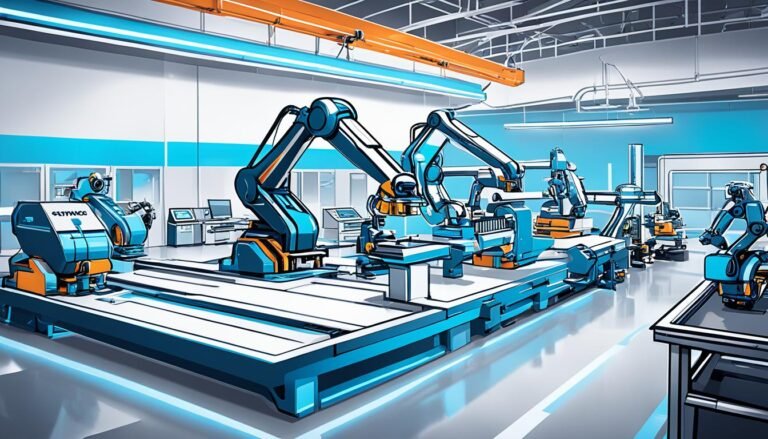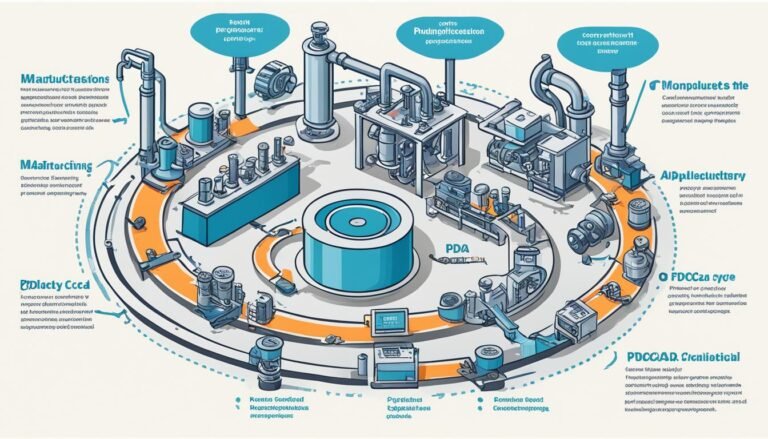Strategic Planning for Manufacturing Managers
Did you know a senior leader can boost success by 75% or more in manufacturing? In today’s fast world, making a strategic plan is key. It makes sure all parts of the business work together well.
This includes planning, scheduling, quality, and inventory management. By doing this, managers can make their operations better, use resources well, and always improve. This helps them meet and beat customer expectations.
Strategic planning is more than just making things run smoothly. It means linking the company’s goals with clear targets. This creates a culture that can quickly adapt to changes in the market.
Studies show that companies with clear goals do better in making more money and cutting costs. Using data from Manufacturing Execution Systems (MES), managers can see what’s happening in real time. This ensures products are top quality everywhere.
Key Takeaways
- Strategic planning is key to boosting success and hitting business goals.
- Using MES data improves how well the supply chain and production run.
- Plans should have clear goals to track progress each quarter.
- Working together across departments helps in putting plans into action.
- Updating the strategic plan yearly helps companies grow based on what they’ve learned.
Understanding the Importance of Strategic Planning in Manufacturing
In today’s competitive world, strategic planning is key for long-term success and adapting to market changes. It boosts efficiency and makes sure the company’s goals match its manufacturing efforts. Strategic planning focuses on important areas like quality control, risk mitigation, and growing market share. These efforts help increase profits and cut down on product development time.
Why Strategic Planning Matters
Strategic planning is vital for setting a future path. About 48 percent of leaders spend less than a day a month on strategy, but many companies don’t hit their goals. By spending more time on strategy, companies get clear goals and make better decisions. This helps in reducing risk mitigation.
Also, involving all team members early in planning boosts teamwork and shared responsibility. This teamwork leads to better alignment, as seen in White Bear Lake Area Schools, MN. They kept projects going during the COVID-19 pandemic thanks to their strategic plan. This shows how strategic planning helps prepare for and get through tough times.
Examples of Strategic Mishaps
Not having or updating strategic plans can lead to big problems. Kodak’s failure is a clear example. It was a leader but didn’t move to digital photography, losing its market edge. This shows the need for being adaptable and forward-thinking to keep a strong market share.
On the other hand, a Harvard Business School study found that 93 percent of successful companies changed their strategies. Courses in strategic planning teach leaders how to lead better, reduce risks, and boost productivity. Also, strategic planning makes things more transparent and builds trust, leading to better motivation and results.
Core Elements of a Successful Manufacturing Strategy
A strong manufacturing strategy has key parts. These parts make sure manufacturing works with the company’s main goals. This keeps companies competitive and ready for changes in the market. Here are the main parts of a good manufacturing strategy.
Competitive Priorities
Choosing what to focus on is key. This means picking quality, reliability, and new ideas. Gündüz Ulusoy (2003) says these choices are about quality, being reliable, and delivering on time. Companies using lean manufacturing aim to cut waste and make processes better.
Managing inventory is also important. It keeps materials flowing without having too much stock. This affects costs and how happy customers are.
Manufacturing Objectives
Manufacturing goals set the direction for how well a business does. These goals include things like costs, market share, profits, and how fast new products come out. Hayes and Wheelwright (1984) say these goals help build a strong base for the business.
Good inventory management means having the right amount of stock. This cuts costs and helps respond quickly to what customers want. Supply chain management makes the whole process from getting materials to delivering products better. This makes things more efficient and customers happier.
Action Plans and Implementation
Action plans show how to put the manufacturing strategy into action. They cover things like how to make products, save energy, and empower employees. The Fourth Industrial Revolution (4IR) talks about using automation and digital tools to make production better and cheaper.
Using these new technologies helps businesses have a strong plan for the future. Lean manufacturing and new software help make things run smoother and solve problems better.
| Core Elements | Details |
|---|---|
| Competitive Priorities | Quality, reliability, design changes, deliveries, new products |
| Manufacturing Objectives | Unit costs, market share, profitability, product development time |
| Action Plans and Implementation | Production processes, energy conservation, employee empowerment |
Strategic Planning for Manufacturing Managers
In today’s fast-changing industrial world, strategic planning for manufacturing managers is key. It means using industry 4.0, automation, and creating a smart factory. This requires careful and forward-thinking steps.
Strategic planning helps with growth, staying relevant, and being strong against unexpected challenges. This approach reduces the bad effects of these challenges. With about 60,099 American manufacturing companies having 21 to 500 workers, and another 187,862 with 1-20 employees, a clear strategy is crucial.
Manufacturers can use digital process management to make operations smoother and more productive. Companies like Kodak, once employing up to 145,000 people but filing for bankruptcy in 2012, show the importance of strong strategic plans. It’s key for manufacturers to be flexible and strong during tough economic times, supply chain issues, skill shortages, and the need for new products, as Deloitte predicts for 2024.
Strategic planning includes six main steps: perspective, core plan, action, structure, management, and renewal. By carefully going through these stages, managers can handle the challenges of industry 4.0 and digital change. This ensures their businesses not only survive but also do well in today’s market. Using new tech, cutting waste with Lean Manufacturing, and meeting customer needs with Mass Customization are key parts of this.
At the end, strategic planning gives manufacturers better efficiency, flexibility, quality control, and competitiveness. These are vital in an age where automation and smart factories lead the industry. By always improving and encouraging innovation, manufacturing managers can build a strong and ready-for-the-future business.
Common Manufacturing Strategy Frameworks
In manufacturing, many strategy frameworks have shown they work well. They help make processes better and use resources wisely. They also help with ongoing improvement and managing inventory well.
Lean Manufacturing
Lean Manufacturing is all about making things more efficient. It focuses on creating value by getting rid of waste and making processes better. By looking closely at each step in production, Lean Manufacturing aims to make things run smoother and use resources better.
This method is based on the Toyota Production System. It’s known for its Just-In-Time (JIT) way of managing inventory. This approach makes things more flexible and quick to respond.
Industry 4.0
Industry 4.0 brings the digital age to manufacturing with the help of IoT, AI, and machine learning. It’s all about making things more connected and automated. This leads to ongoing improvements in how things work.
For example, AI can predict when machines might break down, helping to avoid problems. This makes processes and resource use better. Cyber-physical systems also let us analyze data in real time, making things more efficient.
Supply Chain Management
Supply Chain Management (SCM) is key to smooth operations from getting materials to delivering products. It makes sure inventory, forecasting, and logistics work well. This means resources are used wisely.
Companies like Unilever show how being flexible with strategies can lead to better business results. They highlight the need for adaptable SCM to meet changing market needs.
Looking at these frameworks helps manufacturing managers plan better. Using Lean Manufacturing, Industry 4.0, and Supply Chain Management together creates a strong base for growth and staying ahead in the competition.
Conclusion
Strategic planning is key to doing well in manufacturing and staying strong over time. Charles H. Fine and Arnoldo C. Hax from M.I.T. showed us how important it is to match a company’s manufacturing strategy with its overall goals. They pointed out the need for a detailed strategy to handle complex operations.
When different parts of a company like finance, marketing, and R&D work together, managers can make strong strategies. These strategies lead to real success.
A good strategic plan helps meet current goals and sets the stage for growth and new ideas. Being able to keep up with market changes and new tech, like in the electronics field, is crucial. This helps a company stay ahead.
Planning at all levels makes sure the manufacturing strategy is a team effort. It’s not just for one department. This approach helps the whole company move forward together.
The main goal of a manufacturing strategy is to stay ahead for the long run. Research and examples show us how important strategic planning is. It helps companies have strong points, run smoothly, and plan for new innovations.
So, strategic planning in manufacturing is more than just a task. It’s a key part of making a company successful.
Source Links
- 10 Steps To An Effective Manufacturing Operations Management Strategy
- The Importance of Strategic Planning for Manufacturers – NJMEP
- Strategic Planning: 5 Planning Steps, Process Guide [2024] • Asana
- Why Is Strategic Planning Important? | HBS Online
- 5 Benefits of Strategic Planning
- The Importance of Strategic Planning
- Strategies for Manufacturing: How to Plan for the Future — Katana
- 6 Elements of Effective Strategic Planning
- How to Build Manufacturing Strategies That Actually Work
- Developing a Strategic Plan for a Manufacturing Company
- Develop A Manufacturing Strategy That Works: Examples, Tips & Free Template
- 11 Best Strategic Frameworks For Your Organization
- 20 Strategic Frameworks & Models for Business Success 🎯
- Manufacturing strategy : a methodology and an illustration
- Evolution in the strategic manufacturing planning process of organizations
- Strategic Planning Process: 7 Crucial Steps to Success







